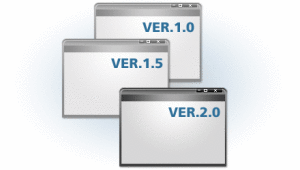 Traditionally, software versions are numbered in series. Version 2 comes after version 1, and so on. If a software company comes out with a minor change or bug fix, they use a decimal number to show the slight difference. Therefore, you often see version 2.1, 2.2, etc. Major changes will get a new full version number, but minor corrections qualify only for a decimal number.
Traditionally, software versions are numbered in series. Version 2 comes after version 1, and so on. If a software company comes out with a minor change or bug fix, they use a decimal number to show the slight difference. Therefore, you often see version 2.1, 2.2, etc. Major changes will get a new full version number, but minor corrections qualify only for a decimal number.
Many computer users avoid the new major improvements like version 2.0 or 3.0, because they suspect major changes will bring major errors in the software. Instead, they wait for version 2.1 or 3.1 to appear on the shelves a few months later. With fe exceptions history has proven this to be a wise decision.
In recent years, Microsoft has abandoned version numbers and started using brand name that are more “catchy” to the consumer. Windows 98, XP, and Vista are great examples. Rightfully, they should probably be called Windows versions 6, 7, and 8. Even the decimal points for the bug fixes have been replaced with something called a Service Pack, which doesn’t sound nearly as buggy.
~ From the book “Understanding the Personal Computer”


